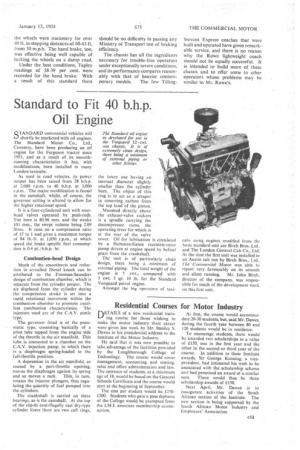Standard to Fit 40 b.h.p.
Page 49

If you've noticed an error in this article please click here to report it so we can fix it.
Oil Engine
STANDARD commercial vehicles will shortly be marketed with oil engines. The Standard Motor Co., Ltd., Coventry, have been producing an oil engine for the Ferguson tractor since 1951, and as a result of its smoothrunning characteristics it has, with modifications, been installed in many London taxicabs.
As used in road vehicles, its power output has been raised from 28 b.h.p. at 2,000 r.p.m. to 40 b.h.p. at 3,000 r.p.m. The major modification is found in the camshaft, whilst, of course, the governor setting is altered to allow for the higher rotational speed.
It is a four-cylindered unit with overhead valves operated by push-rods. The bore is 80.96 mm. and the stroke 101 mm., the swept volume being 2.09 litres. It runs on a compression ratio of 17 to 1 and gives a maximpm torque of 84 lb.-ft. at 1,050 r.p.m., at which speed the brake specific fuel consumption is 0.4 pt./ b.h.p.: hr.
Combustion-bead Design
Much of the smoothness and reduction in so-called Diesel knock can be attributed to the .Freeman-Saunders design of combustion chamber, which is separate from the cylinder proper. The air displaced from the cylinder during the compression stroke is set into a rapid rotational movement within the combustion chamber to promote excellent combustion characteristics. The injectors used are of the C.A.V. pintle type.
The, governor fitted is of the pneumatic type, consisting basically of a pitot tube tapped from the engine side of the throttle in the air manifold. This tube is connected to a chamber on the C.A.V. injection pump, in which there is a diaphragm spring-loaded to the full-throttle position.
A depression in the air manifold, as caused by a part-throttle opening, moves the diaphragm against its spring and so moves a rack. This, in turn, rotates the injector plungers, thus regulating the quantity of fuel pumped into the cylinders.
The crankshaft is carried on three bearings, as is the camshaft. At the top of the slip-fit centrifugally cast dry-type cylinder liners there are two cuff rings, the lower one having an internal diameter slightly smaller than the cylinder bore. The object of this ring is to act as a scraper in removing carbon from the top land of the piston.
Mounted directly above the exhaust-valve rockers is a spindle carrying the deeompressor cams, the operating lever for which is at the rear of the valve cover. Oil for lubrication is circulated by a Hobourn-Eaton eccentric-rotor pump driven at engine speed by helical gears from the crankshaft.
The unit is of particularly clean design, there being a minimum of external piping. The total weight of the engine is 5 cwt., compared with 3 cwt. 3 qr. 10 lb. for the Standard Vanguard petrol engine.
Amongst the big operators of taxi cabs using engines modified from tht basic standard unit are Birch Bros. Ltd.. and The London General Cab Co., Ltd. At the time the first unit was installed in an Austin cab run by Birch Bros., Ltd.. The Commercial Motor was able to report very favourably on its smooth and silent running. Mr. John Birch. director of the company, was responsible for much of the development work on this first unit.




































































































